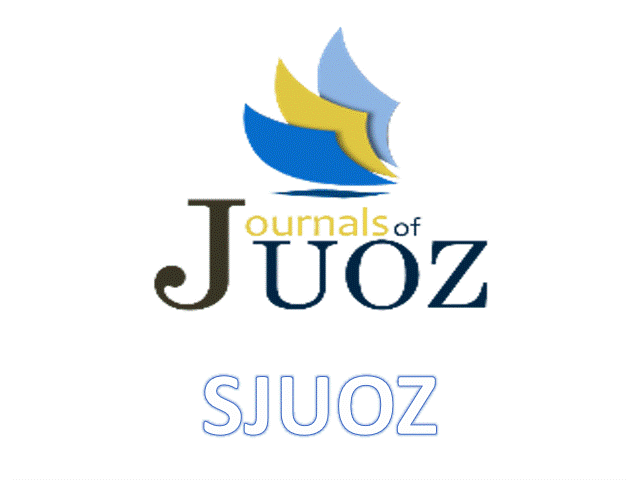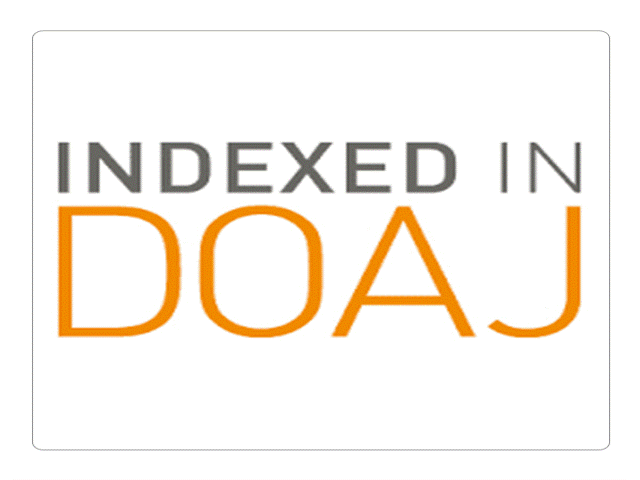VIRULOTYPING OF LISTERIA MONOCYTOGENES ISOLATED FROM HUMAN AND FOOD PRODUCTS SAMPLES USING MULTIPLEX PCR IN DUHOK PROVINCE, IRAQ
DOI:
https://doi.org/10.25271/sjuoz.2023.11.2.994Keywords:
Listeria monocytogenes, virulence genes, Food products, Duhok, multiplex PCRAbstract
Listeria monocytogenes is a facultative intracellular, food-borne zoonotic-bacterium causing life-threatening infections worldwide with a significant mortality rate in both humans and animals. The aim of the study was to examine the existence of five crucial virulence-associated genes (inIA, inIB, inIC, inIJ and prfA) in 48 L. monocytogenes isolates that were obtained from human and different food products using multiplex Polymerase Chain Reaction (PCR). The most frequent genes among isolates were inIC (93.8%), inIB (91.7%) and inIJ (83.3) followed by prfA (81.2%) and inIA (79.2%). Regardless of the source of bacteria, all tested isolates showed the prevalence of multiple virulence-associated genes. The presence of three virulence genes was detected in 20.8%, four of five virulence genes were found in 33.3% of isolates, and 45.8% of isolates carried all five virulence genes. In conclusion, the presence of potential virulence genes increases the pathogenicity of L. monocyogenes. Furthermore, the occurrence of multiple virulence related genes in a single isolate may imply the presence of highly virulent isolates. To investigate the connection between those genes and clinical outcomes, more research is needed.
Downloads
References
Abdeen, E. E., Mousa, W. S., Harb, O. H., Fath-Elbab, G. A., Nooruzzaman, M., Gaber, A., Alsanie, W. F., & Abdeen, A. (2021). Prevalence, antibiogram and genetic characterization of listeria monocytogenes from food products in Egypt. Foods, 10(6), 1–13. https://doi.org/10.3390/foods10061381
Al-Brefkani, A. M. T., & Mammani, I. M. A. (2019a). SEASONAL CHANGES IN THE OCCURRENCE OF LISTERIA MONOCYTOGENES IN DUHOK PROVINCE. 7(1), 5–9. https://doi.org/10.25271/sjuoz.2019.7.1.549
Al-Brefkani, A. M. T., & Mammani, I. M. A. (2019b). Characterisation of Listeria monocytogenes from Food and Human Clinical Samples at Duhok, Kurdistan Region of Iraq. Journal of Pure and Applied Microbiology, 13(4), 2215–2226. https://doi.org/10.22207/JPAM.13.4.35
Assafi, M. S. A., Ibrahim, N. M. R., Hussein, N. R., Taha, A. A., & Balatay, A. A. (2015). Urinary Bacterial Profile and Antibiotic Susceptibility Pattern among Patients with Urinary Tract Infection in Duhok City, Kurdistan Region, Iraq. International Journal of Pure & Applied Sciences & Technology, 30(2), 54–63.
Campuzano-Maya, G. (2014). Hematologic manifestations of Helicobacter pylori infection. World Journal of Gastroenterology: WJG, 20(36), 12818.
CDC. (2016). People at risk. Retrieved August,8, 2022, from
https://www.cdc.gov/Listeria/risk.html#:~:text=Listeria%20is%20most%20likely%20 to,they%20rarely%20become%20seriously%20ill.
Disson, O., & Lecuit, M. (2013). Invitro and invivo models to study human listeriosis: Mind the gap. Microbes and Infection, 15(14–15), 971–980. https://doi.org/10.1016/j.micinf.2013.09.012
Dominguez Rodriguez, L., Vazquez Boland, J. A., Fernandez Garayzabal, J. F., Echalecu Tranchant, P., Gomez-Lucia, E., Rodriguez Ferri, E. F., & Suarez Fernandez, G. (1986). Microplate technique to determine hemolytic activity for routine typing of Listeria strains. Journal of Clinical Microbiology, 24(1), 99–103.
Du, X., Zhang, X., Wang, X., Su, Y., Li, P., & Wang, S. (2017). Isolation and characterization of Listeria monocytogenes in Chinese food obtained from the central area of China. Food Control, 74, 9–16.
El-Demerdash, A. S., & Raslan, M. T. (2019). Molecular characterization of listeria monocytogenes isolated from different animal-origin food items from urban and rural areas. Advances in Animal and Veterinary Sciences, 7(Special Issue 2), 51–56. https://doi.org/10.17582/journal.aavs/2019/7.s2.51.56
Farber, J. M., & Canada, H. (2015). Listeria monocytogenes , a Food-Borne Pathogen. October 1991.
FDA. (2019a). Listeria (Listeriosis). Retrieved August 10, 2022 from” https://www.fda.gov/food/foodborne-pathogens/listeria-listeriosis
Hudson, J. A., Lake, R. J., Savill, M. G., Scholes, P., & McCormick, R. E. (2001). Rapid detection of Listeria monocytogenes in ham samples using immunomagnetic separation followed by polymerase chain reaction. Journal of Applied Microbiology, 90(4), 614–621.
Hussein, N. R., Mohammadi, M., Talebkhan, Y., Doraghi, M., Letley, D. P., Muhammad, M. K. & Atherton, J. C. (2008). Differences in virulence markers between Helicobacter pylori strains from Iraq and those from Iran: potential importance of regional differences in H. pylori-associated disease. Journal of clinical microbiology, 46(5), 1774-1779.
Hussein, N., Salih, R. S., & Rasheed, N. A. (2019). Prevalence of methicillin-resistant Staphylococcus aureus in hospitals and community in Duhok, Kurdistan region of Iraq. International Journal of Infection, 6(2).
Ireton, K., Mortuza, R., Gyanwali, G. C., Gianfelice, A., & Hussain, M. (2021). Role of internalin proteins in the pathogenesis of Listeria monocytogenes. Molecular Microbiology, 116(6), 1407–1419. https://doi.org/10.1111/mmi.14836
Jamali, H., Paydar, M., Ismail, S., Looi, C. Y., Wong, W. F., Radmehr, B., & Abedini, A. (2015). Prevalence, antimicrobial susceptibility and virulotyping of Listeria species and Listeria monocytogenes isolated from open-air fish markets. BMC Microbiology, 15(1), 1–7. https://doi.org/10.1186/s12866-015-0476-7
Johnson, J., Jinneman, K., Stelma, G., Smith, B. G., Lye, D., Messer, J., Ulaszek, J., Evsen, L., Gendel, S., & Bennett, R. W. (2004). Natural atypical Listeria innocua strains with Listeria monocytogenes pathogenicity island 1 genes. Applied and Environmental Microbiology, 70(7), 4256–4266.
Kaur, S., Singh, R., Sran, M. K., & Gill, J. P. S. (2018). Molecular characterization of Listeria monocytogenes in white meat samples from Punjab, India. Indian Journal of Animal Research, 52(11), 1635–1641. https://doi.org/10.18805/ijar.B-3414
Klein, P. G., & Juneja, V. K. (1997). Sensitive detection of viable Listeria monocytogenes by reverse transcription-PCR. Applied and Environmental Microbiology, 63(11), 4441–4448.
Kose, A., & Yakupogullari, Y. (2015). A Rapidly Fatal Sepsis Caused by Listeria Monocytogenes Type-4b in A Patient with Chronic Renal Failure. Jundishapur Journal of Microbiology, 8(3).
Lamond, N. M., & Freitag, N. E. (2018). Vertical transmission of listeria monocytogenes: Probing the balance between protection from pathogens and fetal tolerance. Pathogens, 7(2). https://doi.org/10.3390/pathogens7020052
Liu, D., Lawrence, M. L., Austin, F. W., & Ainsworth, A. J. (2007). A multiplex PCR for species- and virulence-specific determination of Listeria monocytogenes. Journal of Microbiological Methods, 71(2), 133–140. https://doi.org/10.1016/j.mimet.2007.08.007
Orsi, R. H., & Wiedmann, M. (2016). Characteristics and distribution of Listeria spp., including Listeria species newly described since 2009. Applied Microbiology and Biotechnology, 100(12), 5273–5287.
Osman, K. M., Kappell, A. D., Fox, E. M., Orabi, A., & Samir, A. (2019). Resistance , and Phylogenetic Analysis of Biofilm-Producing Listeria monocytogenes Isolated from Di ff erent Ecological Niches in Egypt : Food , Humans , Animals , and Environment. Pathogens, 9(5).
Rasheed, N. A., & Hussein, N. R. (2020a). Characterization of different virulent factors in methicillin-resistant Staphylococcus aureus isolates recovered from Iraqis and Syrian refugees in Duhok city, Iraq. PloS One, 15(8), e0237714.
Rasheed, N., & Hussein, N. R. (2020b). The nasal carriage of Staphylococcus aureus and its antimicrobial susceptibility pattern in secondary school students in Kurdistan region, Iraq. Journal of Kermanshah University of Medical Sciences, 24(1).
Schlech III, W. F. (2019). Epidemiology and clinical manifestations of Listeria monocytogenes infection. Microbiology Spectrum, 7(3), 3–7.
Tahoun, A. B. M. B., Abou Elez, R. M. M., Abdelfatah, E. N., Elsohaby, I., El-Gedawy, A. A., & Elmoslemany, A. M. (2017). Listeria monocytogenes in raw milk, milking equipment and dairy workers: Molecular characterization and antimicrobial resistance patterns. Journal of Global Antimicrobial Resistance, 10(April 2019), 264–270. https://doi.org/10.1016/j.jgar.2017.07.008
Tan, M. F., Siow, C. C., Dutta, A., Mutha, N. V. R., Wee, W. Y., Heydari, H., Tan, S. Y., Ang, M. Y., Wong, G. J., & Choo, S. W. (2015). Development of ListeriaBase and comparative analysis of Listeria monocytogenes. BMC Genomics, 16(1), 1–19.
Vasanthakrishnan, R. B., de las Heras, A., Scortti, M., Deshayes, C., Colegrave, N., & Vázquez-Boland, J. A. (2015). PrfA regulation offsets the cost of Listeria virulence outside the host. Environmental Microbiology, 17(11), 4566–4579. https://doi.org/10.1111/1462-2920.12980
Vimentin, H. C., Ghosh, P., Halvorsen, E. M., Ammendolia, D. A., Mor-vaknin, N., & Riordan, M. X. D. O. (2018). Invasion of the Brain by Listeria monocytogenes Is Mediated by InIF and host cell vimentin. MBio, 9(1), 1–11.
Ward, T. J., Gorski, L., Borucki, M. K., Mandrell, R. E., Hutchins, J., & Pupedis, K. (2004). Intraspecific phylogeny and lineage group identification based on the prfA virulence gene cluster of Listeria monocytogenes. Journal of Bacteriology, 186(15), 4994–5002. https://doi.org/10.1128/JB.186.15.4994-5002.2004
Published
How to Cite
Issue
Section
License
Copyright (c) 2023 Azad M. Al-Brefkani, Narin A. Rasheed, Nawfal R. Hussein

This work is licensed under a Creative Commons Attribution 4.0 International License.
Authors who publish with this journal agree to the following terms:
- Authors retain copyright and grant the journal right of first publication with the work simultaneously licensed under a Creative Commons Attribution License [CC BY-NC-SA 4.0] that allows others to share the work with an acknowledgment of the work's authorship and initial publication in this journal.
- Authors are able to enter into separate, additional contractual arrangements for the non-exclusive distribution of the journal's published version of the work, with an acknowledgment of its initial publication in this journal.
- Authors are permitted and encouraged to post their work online.








